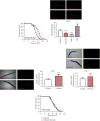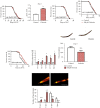Orientin Prolongs the Longevity of Caenorhabditis elegans and Postpones the Development of Neurodegenerative Diseases via Nutrition Sensing and Cellular Protective Pathways
- PMID: 35237385
- PMCID: PMC8885179
- DOI: 10.1155/2022/8878923
Orientin Prolongs the Longevity of Caenorhabditis elegans and Postpones the Development of Neurodegenerative Diseases via Nutrition Sensing and Cellular Protective Pathways
Abstract
Age is the major risk factor for most of the deadliest diseases. Developing small molecule drugs with antiaging effects could improve the health of aged people and retard the onset and progress of aging-associated disorders. Bioactive secondary metabolites from medicinal plants are the main source for development of medication. Orientin is a water-soluble flavonoid monomer compound widely found in many medicinal plants. Orientin inhibits fat production, antioxidation, and anti-inflammatory activities. In this study, we explored whether orientin could affect the aging of C. elegans. We found that orientin improved heat, oxidative, and pathogenic stress resistances through activating stress responses, including HSF-1-mediated heat shock response, SKN-1-mediated xenobiotic and oxidation response, mitochondria unfolded responses, endoplasmic unfolded protein response, and increased autophagy activity. Orientin also could activate key regulators of the nutrient sensing pathway, including AMPK and insulin downstream transcription factor FOXO/DAF-16 to further improve the cellular health status. The above effects of orientin reduced the accumulation of toxic proteins (α-synuclein, β-amyloid, and poly-Q) and delayed the onset of neurodegenerative disorders in AD, PD, and HD models of C. elegans and finally increased the longevity and health span of C. elegans. Our results suggest that orientin has promising antiaging effects and could be a potential natural source for developing novel therapeutic drugs for aging and its related diseases.
Copyright © 2022 Yuan Qu et al.
Conflict of interest statement
The authors declare that there is no conflict of interest.
Figures









Similar articles
-
Orientin: a comprehensive review of a promising bioactive flavonoid.Inflammopharmacology. 2025 Apr;33(4):1713-1728. doi: 10.1007/s10787-025-01690-5. Epub 2025 Mar 8. Inflammopharmacology. 2025. PMID: 40056319 Free PMC article. Review.
-
Trigonelline Extends the Lifespan of C. Elegans and Delays the Progression of Age-Related Diseases by Activating AMPK, DAF-16, and HSF-1.Oxid Med Cell Longev. 2021 Sep 25;2021:7656834. doi: 10.1155/2021/7656834. eCollection 2021. Oxid Med Cell Longev. 2021. PMID: 34616504 Free PMC article.
-
Hibiscus sabdariffa L. extract prolongs lifespan and protects against amyloid-β toxicity in Caenorhabditis elegans: involvement of the FoxO and Nrf2 orthologues DAF-16 and SKN-1.Eur J Nutr. 2020 Feb;59(1):137-150. doi: 10.1007/s00394-019-01894-w. Epub 2019 Feb 1. Eur J Nutr. 2020. PMID: 30710163
-
Glochidion zeylanicum leaf extracts exhibit lifespan extending and oxidative stress resistance properties in Caenorhabditis elegans via DAF-16/FoxO and SKN-1/Nrf-2 signaling pathways.Phytomedicine. 2019 Nov;64:153061. doi: 10.1016/j.phymed.2019.153061. Epub 2019 Jul 31. Phytomedicine. 2019. PMID: 31401497
-
Unveiling the Longevity Potential of Natural Phytochemicals: A Comprehensive Review of Active Ingredients in Dietary Plants and Herbs.J Agric Food Chem. 2024 Nov 13;72(45):24908-24927. doi: 10.1021/acs.jafc.4c07756. Epub 2024 Oct 31. J Agric Food Chem. 2024. PMID: 39480905 Free PMC article. Review.
Cited by
-
Orientin: a comprehensive review of a promising bioactive flavonoid.Inflammopharmacology. 2025 Apr;33(4):1713-1728. doi: 10.1007/s10787-025-01690-5. Epub 2025 Mar 8. Inflammopharmacology. 2025. PMID: 40056319 Free PMC article. Review.
-
Orientin downregulating oxidative stress-mediated endoplasmic reticulum stress and mitochondrial dysfunction through AMPK/SIRT1 pathway in rat nucleus pulposus cells in vitro and attenuated intervertebral disc degeneration in vivo.Apoptosis. 2022 Dec;27(11-12):1031-1048. doi: 10.1007/s10495-022-01770-9. Epub 2022 Sep 20. Apoptosis. 2022. PMID: 36125665
-
Effects of Vegetal Extracts and Metabolites against Oxidative Stress and Associated Diseases: Studies in Caenorhabditis elegans.ACS Omega. 2023 Feb 27;8(10):8936-8959. doi: 10.1021/acsomega.2c07025. eCollection 2023 Mar 14. ACS Omega. 2023. PMID: 36936291 Free PMC article. Review.
-
Orientin Reverses Premature Senescence in Equine Adipose Stromal Cells Affected by Equine Metabolic Syndrome Through Oxidative Stress Modulation.Int J Mol Sci. 2025 Jul 17;26(14):6867. doi: 10.3390/ijms26146867. Int J Mol Sci. 2025. PMID: 40725115 Free PMC article.
-
In Vitro Probiotic Properties and In Vivo Anti-Ageing Effects of Lactoplantibacillus plantarum PFA2018AU Strain Isolated from Carrots on Caenorhabditis elegans.Microorganisms. 2023 Apr 21;11(4):1087. doi: 10.3390/microorganisms11041087. Microorganisms. 2023. PMID: 37110510 Free PMC article.
References
MeSH terms
Substances
LinkOut - more resources
Full Text Sources
Medical
Research Materials
Miscellaneous

